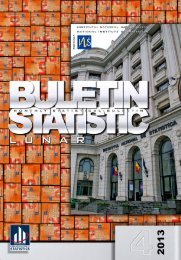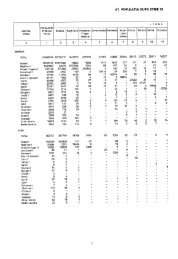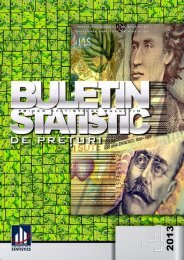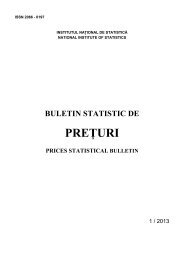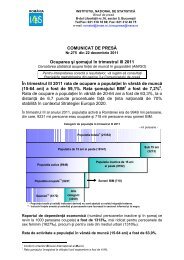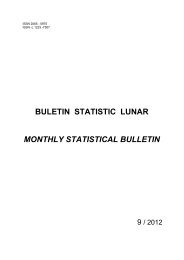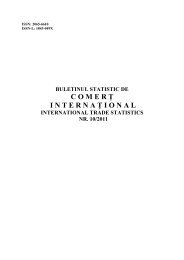BULETIN STATISTIC LUNAR MONTHLY STATISTICAL BULLETIN
BULETIN STATISTIC LUNAR MONTHLY STATISTICAL BULLETIN
BULETIN STATISTIC LUNAR MONTHLY STATISTICAL BULLETIN
You also want an ePaper? Increase the reach of your titles
YUMPU automatically turns print PDFs into web optimized ePapers that Google loves.
construite în conformitate cu prevederileRegulamentului Consiliului şi ParlamentuluiEuropean nr. 450/2003 privind indicii costului demuncă.Indicii trimestriali al costului forţei de muncă secalculează ca indici de tip Laspeyres, pentrucostul total cu forţa de muncă şi cele douăcomponente ale acestuia: cheltuieli directe(salariale) şi cheltuieli indirecte (non-salariale),cu anul de referinţă 2008.Indicii trimestriali ai costului forţei de muncă suntcalculaţi ca indici provizorii pentru anul (N),urmând a fi recalculaţi ca definitivi în anul (N+1),când devin disponibile datele din ancheta anualăasupra costului forţei de muncă.Costul total cu forţa de muncă - reprezintătotalitatea cheltuielilor – directe şi indirecte –suportate de angajator cu forţa de muncăsalariată. Conform metodologiei europene, seexclud cheltuielile suportate de angajator cuformarea profesională a angajaţilor, recrutareapersonalului şi echipamentul de protecţie.Cheltuielile directe cu forţa de muncă - includsumele brute plătite din fondul de salarii pentrutimpul lucrat (inclusiv premii) pentru timpulnelucrat, drepturile în natură ca remunerare amuncii (potrivit prevederilor din contractelecolective de muncă), sumele brute plătitesalariaţilor (ca stimulente) din profitul net realizatde unitate, sumele brute plătite din alte fonduri(inclusiv drepturi în natură) acordate conformlegislaţiei în vigoare.Cheltuielile indirecte cu forţa de muncă -includ contribuţiile angajatorului la fondurile deasigurări şi protecţie socială (şomaj, sănătateetc.), sumele brute plătite salariaţilor carepărăsesc unitatea (ieşirea la pensie, transfer,detaşare etc.), sumele brute plătite pentruîntreruperi ale lucrului neimputabile slariaţilor,alte cheltuieli cu forţa de muncă.Costul mediu orar al forţei de muncă reprezintăraportul dintre cheltuielile angajatorului cu forţade muncă şi timpul efectiv lucrat.Timpul efectiv lucrat cuprinde numărul total deore lucrate în program normal de lucru şinumărul de ore lucrate suplimentar (în zilelelucrătoare, peste programul normal de lucru şi înzilele de repaus săptămânal, sărbători legale şialte zile nelucrătoare).Pe lângă seria indicilor trimestriali ai costuluiforţei de muncă în formă brută (neajustată),începând cu trimestrul IV 2007, se calculează,trimestrial, şi seriile în formă:a) ajustată după efectul zilelor lucrătoare;b) ajustată după efectul zilelor lucrătoare şisezonier,eliminându-se efectul variaţiei numărului de zilelucrătoare de la un trimestru la altul, precum şiefectul variaţiei sezoniere. Ajustarea s-a realizatprin metoda regresivă, în conformitate cuRegulation no. 450/2003 and the EuropeanParliament concerning the labour cost index.The quarterly labour cost indices are calculatedas Laspeyres type indices for total labour costsand its two components: direct expenditure(salary) and indirect ones (non-salary), with 2008as reference year.The quarterly labour cost indices are calculatedas provisional indices for the year (N) andrecalculated as final ones during the year (N+1),when data from the annual survey on labourcosts become available.Total labour cost – represents total expenditure– direct remuneration and other expenditure –incurred by the employer with labour force.According to European methodology, vocationaltraining costs, recruitment costs and expenditureon working clothes are excluded.Wage and salary costs – include grosspayments as direct remuneration for hoursworked (including bonuses), payment for daysnot worked, payment in kind (according tocollective agreements), gross payment from netprofit of the unit, gross payments from otherfunds (including in kind) according to nationallegislation in force.Other labour costs (non-wages costs) – includethe employers’ social contributions (forunemployment, health etc.), gross payment foremployees leaving the unit (retirement, transfer,detachment etc.), gross payments for workbreaks not-imputed to the employees, otherlabour costs.Average hourly labour cost represents theratio between the employers’ costs as result ofengaging the labour work force and the numberof hours actually worked.Number of hours actually worked includes thetotal number of hours worked during the usualworking time and the over time (additional to thenormal working hours, during the weekends,holidays etc.).Besides the series of unadjusted quarterlyindices of labour cost, starting with the fourthquarter of 2007, there are also quarterlycalculated the series:a) adjusted with working days effect;b) adjusted with seasonal and working dayseffectbeing eliminated the variation effect of workingdays number from one quarter to another, aswell as effect of seasonal variation. Theadjustment was done by regressive method,202



